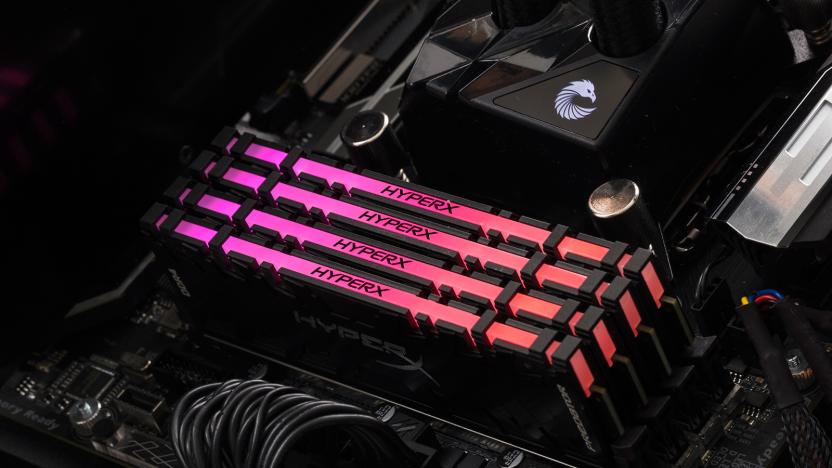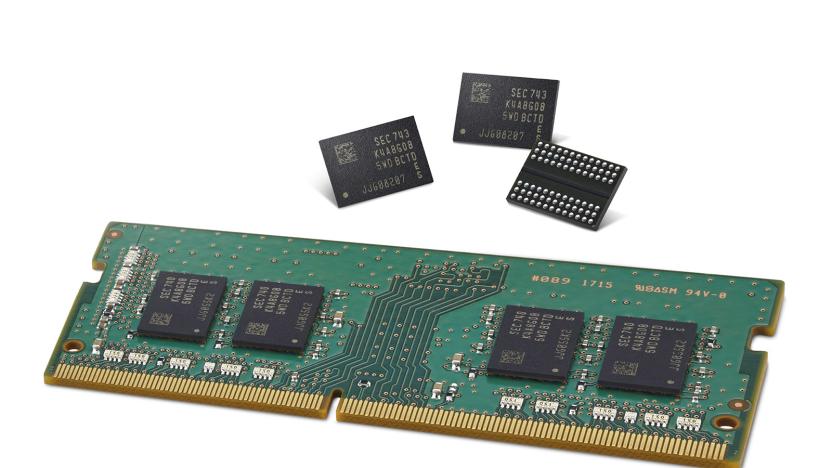ddr4
Latest

Intel's desktop 9th-generation Core chips can handle 128GB of RAM
To date, Intel's mainstream processors haven't supported more than 64GB of RAM. That's not a crisis-inducing problem right now (only demanding pros are likely to notice), but the time when you'll want more is on the horizon. Thankfully, Intel is prepared. The company has confirmed to AnandTech that its desktop 9th-generation Core processors support up to 128GB of DDR4 RAM. Newer, denser memory technology makes that possible, the company said. An update in "a few months' time" will enable the extra headroom.

HyperX memory improves your PC's light show with infrared
Many PC enthusiasts use light-up RAM to add a flair to their systems. But creating a proper, synchronized light show isn't always easy. Even if you have the right motherboard, compatible RAM and the necessary software, there's no guarantee of a harmonious display. HyperX wants to fix that: it's introducing new Predator DDR4 modules that can use infrared light to sync their RGB illumination. There's no guesswork and no external cables -- you can just assume your lights will pulse together using power directly from the motherboard.

Samsung's faster, smaller DRAM chips are coming to your next PC
Samsung has built the smallest 8-gigabit DDR4 RAM chip ever using its second-generation 10-nanometer manufacturing tech, it said in a news release. The chips are 15 percent more energy efficient and run 10 percent faster than the last generation, launched just 20 months ago. Productivity for the chips is also up 30 percent, meaning that wafer throughput and yields will let it build more of the chips in the same time. That should make RAM for your computer cheaper and easier to find in the near future.

Samsung first to market with 10-nanometer DRAM
Intel may have delayed its 10-nanometer CPUs, but all systems are go for Samsung's 10-nanometer-class DRAM chips. The company is now mass producing the first DDR4 chips using the tech in 8Gb sizes, ahead of competitors SK Hynix and Micron.It will produce SIMM modules this year varying from 4GB for laptops up to 128GB for enterprise servers. Samsung also promised to reveal 10-nanometer mobile DRAM "in the near future."

Intel flaunts 8-core Extreme Edition Haswell with support for DDR4 memory
Since Intel's next Haswell chips are aimed squarely at enthusiasts, what better place to unveil them than at the Game Developer's Conference? Aimed at power users, the 4th-gen Core-i7 Extreme Edition CPU will feature eight unlocked cores and 16 threads, trumping the last model's six cores. It'll also support the latest DDR4 memory standard for much higher transfer speeds and lower power drain than DDR3. Also arriving soon is an unlocked 4th-gen "Devil's Canyon" Core chip for overclockers and a "Black Brook" reference all-in-one PC packed with tech like the RealSense 3-D camera (see the video after the break). Finally, Intel revealed that its 5th-gen Broadwell 14-nanometer processors will be available unlocked and with Iris graphics. While those chips were delayed, the new 4th-gen CPUs will arrive in mid-2014 -- so it might be prudent to put off any upgrades. Update: Intel has informed us that the unlocked 4th-gen chips are code-named "Devil's Canyon," not the Extreme Edition CPU. We've updated the post to reflect that.

Samsung's cranking out DDR4 memory for faster, more efficient servers (updated)
DDR4 memory is finally in mass production, as Samsung Semiconductor announced it's churning out 4GB 4Gb (512MB) modules, based on "20nm-class" process technology. 32GB sticks like the ones shown above are headed for the premium server market, where Samsung claims their higher speeds (up to 2,667 Mb/s) make for higher performance and 30 percent less power consumption than DDR3. The company claims this is the world's smallest and highest performing 4Gb RAM chip, and we expect it won't stop there -- when Samsung showcased the technology in 2011 it claimed speeds could eventually reach as high as 4Gbps. Update: It's four gigabits, not gigabytes -- thanks for the corrections, everyone.

JEDEC announces final DDR4 RAM specification
A couple of companies have been jumping the gun on DDR4 production, but the JEDEC Solid State Technology Association is finally bringing order to the industry by releasing its official standard for the next-gen DRAM. It calls for "higher performance, with improved reliability and reduced power" -- which we roughly take to mean: less gigs for better rigs. The DDR4 per-pin data rate standard is 1.6 gigatransfers per second (GT/s) at the minimum and 3.2 GT/s at the top-end, although this cap is expected to increase in future updates (given that DDR3 also surpassed its initial target). Speeds will begin at 2133MHz, a significant jump from your average DDR3 stick, and will also operate at lower power thanks to the Pseudo Open Drain Interface. Check out the PR below if you want to delve deeper into the specs, and if even that's not enough to sate you, head to the source link below to tackle the full documentation. Godspeed!

Micron teases working DDR4 RAM module, aims for late 2012 production
JEDEC is still finalizing the standards for DDR4, but that doesn't mean component manufacturers are holding back on developing the tech now. Samsung announced the first DDR4 DRAM module last year, and now Micron has announced that it's developed a working part of its own. Using its 30-nanometer technology, the 4GB x8 part is just the first of many products in the company's DDR4 portfolio -- it will expand to include x16 and x32 parts with initial speeds of 2400 MT/s and eventually the JEDEC's targeted of 3200 MT/s. So when will DDR3 seem like a distant relic? Well, Micron is already sending around samples to clients, and it hopes to begin full-scale production by the end of the year. As always, jump past the break for the full press release.

Samsung develops DDR4 memory with up to 40 percent better energy efficiency than DDR3
Samsung's famed lead in component manufacturing is being extended today with the announcement of a DDR4 DRAM stick that can perform read and write operations using up to 40 percent less power than the old/current DDR3 stuff. Bandwidth maxes out at 2.13Gbps at 1.2V, while Pseudo Open Drain technology assists in minimizing the battery impact. Over time, Samsung projects the new DRAM modules will hit 4Gbps speeds. It's working away with server makers right now in order to achieve JEDEC certification, but the target market will clearly be laptops and other mobile devices, where energy-frugal memory like this would best be appreciated. Check out Samsung's PR after the break.




